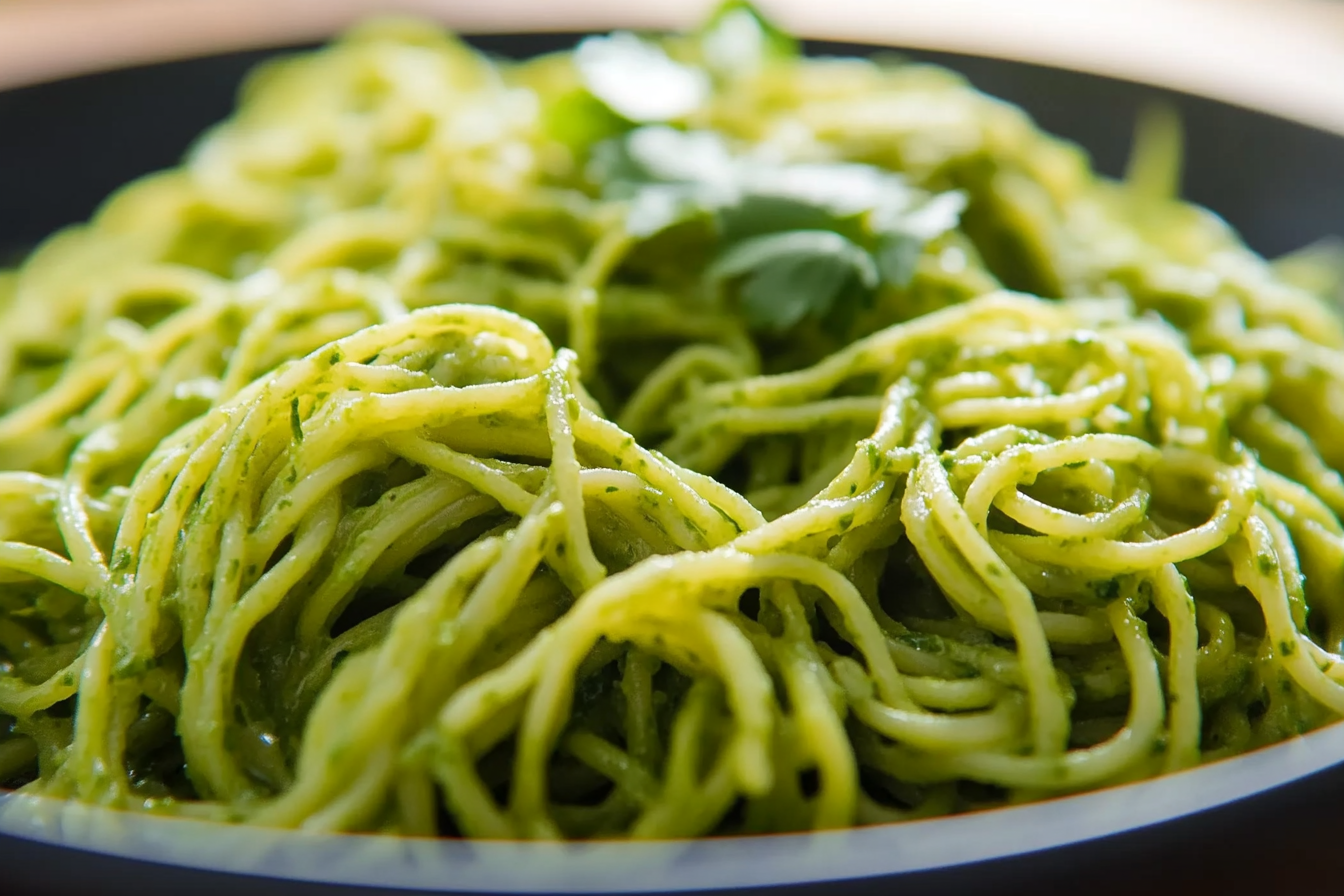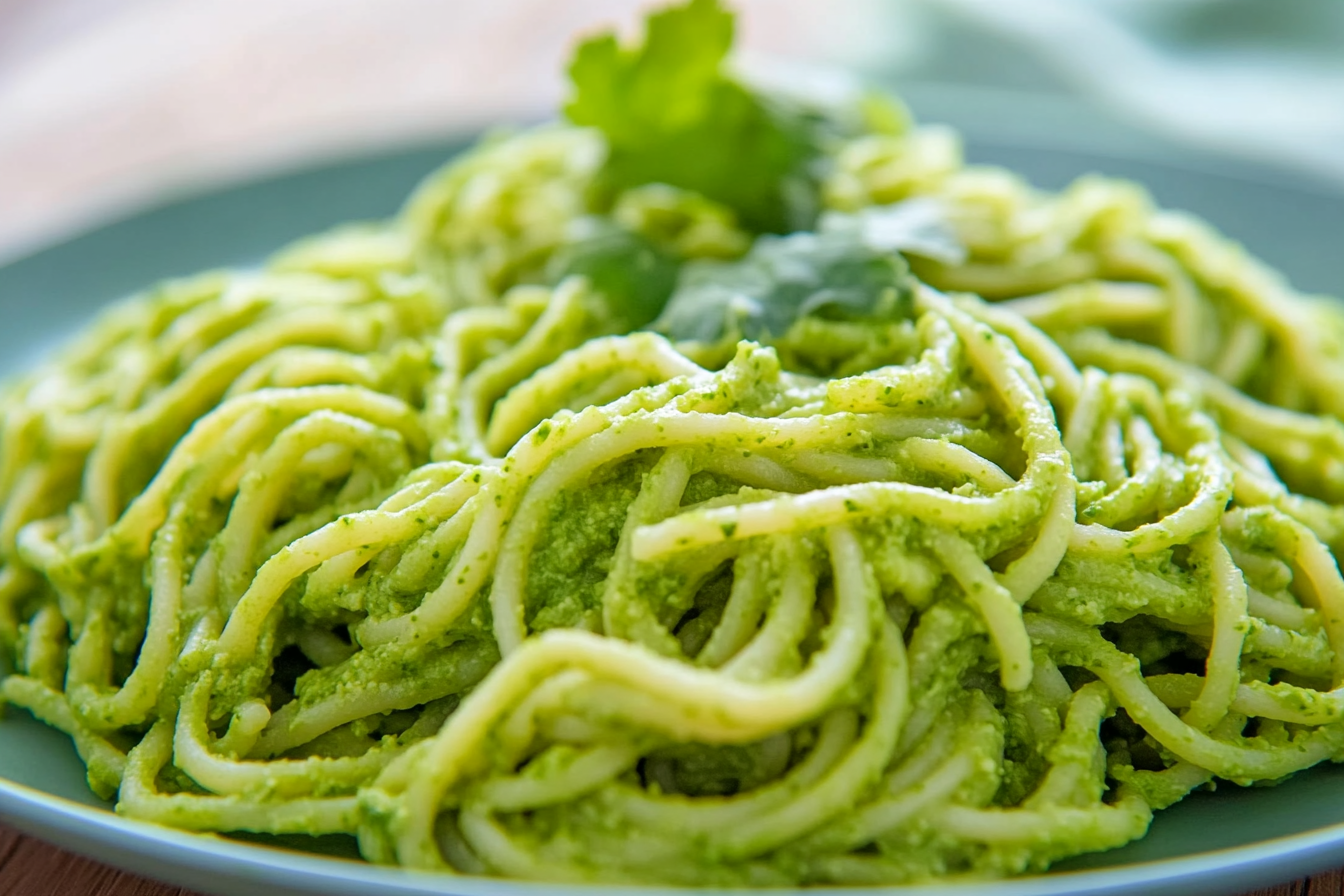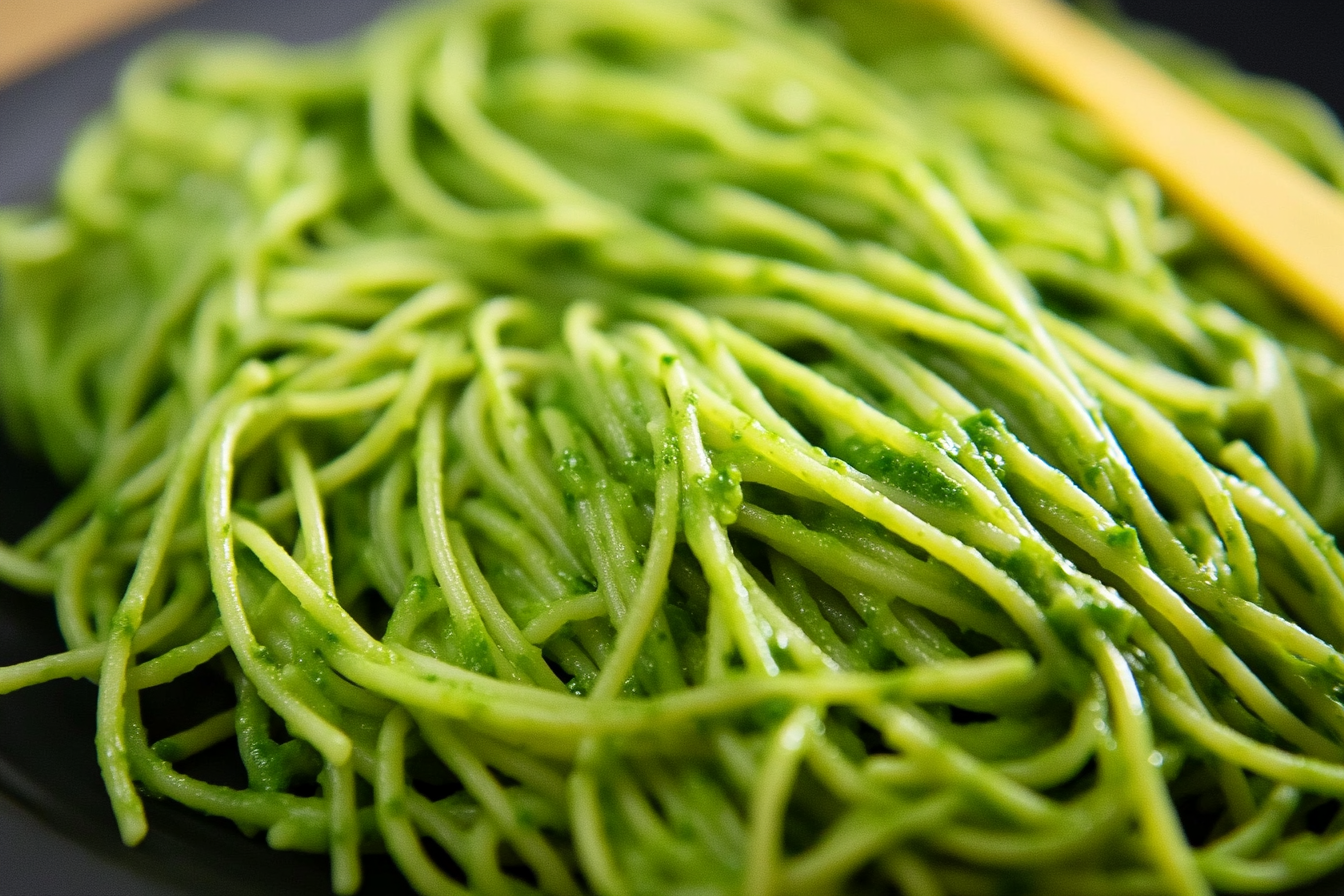Green pasta sauce is a vibrant and versatile sauce that has gained popularity worldwide. Whether it’s the classic pesto made from fresh basil or a more modern spinach-based cream sauce, green pasta sauces offer a variety of flavors, textures, and nutritional benefits. This article will provide a comprehensive look into the ingredients, preparation methods, variations, health benefits, and pairing options for green pasta sauce.
We’ll also explore various ways to use green pasta sauce beyond pasta, answer frequently asked questions, and provide pro tips to make your green sauce perfect every time. With over 4000 words of detailed guidance, this guide will help you become a master at making and using green pasta sauce.
What is Green Pasta Sauce?
Green pasta sauce refers to any sauce that uses green ingredients like basil, spinach, or other leafy greens as the base. These sauces are known for their vibrant color, fresh taste, and healthy properties.
The most famous green pasta sauce is pesto, which originates from Genoa, Italy, and is made from a blend of basil, pine nuts, Parmesan, olive oil, and garlic. However, there are many variations of green pasta sauce that use different herbs, vegetables, and even nuts to create diverse flavors.
Whether you’re making a quick weeknight meal or a gourmet dinner, green pasta sauce can be a healthy and delicious option. Let’s dive into the core ingredients that define this sauce.
Common Ingredients in Green Pasta Sauce
1. Leafy Greens
The primary ingredient in most green pasta sauces is some form of leafy green. The choice of green will dictate the flavor profile of your sauce.
- Basil: The classic choice for pesto, basil offers a sweet, slightly peppery flavor with a fragrant aroma. It’s also rich in vitamin K, essential for bone health. Basil is easy to grow in home gardens, making it accessible and affordable for many.
- Spinach: Spinach is a versatile option, offering a milder taste than basil. It blends well into creamy sauces and is often used to boost the nutrient content of a dish. Spinach is high in iron, calcium, and vitamins A and C, making it a powerhouse green for both flavor and nutrition.
- Arugula: Known for its peppery flavor, arugula can add a bit of spice to your green sauce. It’s great for those who want a bold, tangy taste. Arugula is also rich in vitamin K and folate, contributing to overall health.
- Parsley: A milder herb, parsley adds a fresh, grassy note to green sauces. It’s often used in combination with other greens like basil or cilantro for a more balanced flavor. Parsley is rich in antioxidants and vitamin C, providing both flavor and health benefits.
- Cilantro: Cilantro adds a fresh, citrusy note to green sauces. It’s more commonly used in fusion dishes or non-traditional pasta sauces, offering a refreshing twist.
2. Herbs and Spices
In addition to leafy greens, many green pasta sauces feature a variety of herbs and spices that enhance the flavor. These can include:
- Mint: Adds a refreshing element, particularly in summer dishes.
- Oregano: A classic Mediterranean herb, oregano can add depth to your sauce.
- Garlic: Found in almost all green pasta sauces, garlic adds a pungent, savory element.
3. Nuts and Seeds
Nuts and seeds are commonly used to add texture and richness to green pasta sauces.
- Pine Nuts: These are the traditional choice for pesto, offering a creamy texture and a slightly sweet, nutty flavor. Pine nuts are high in healthy fats and protein, making them a nutritious addition.
- Walnuts: An alternative to pine nuts, walnuts offer a richer, earthier flavor. They are also more affordable and accessible for many home cooks.
- Sunflower Seeds: For those with nut allergies, sunflower seeds provide a great alternative. They add a similar texture without the risk of allergens.
4. Cheese
Cheese plays a key role in green pasta sauces, particularly in pesto. It adds saltiness, creaminess, and depth of flavor.
- Parmesan: The go-to cheese for pesto, Parmesan offers a sharp, salty flavor that balances the sweetness of basil and the richness of nuts.
- Pecorino: Another common cheese in Italian cuisine, Pecorino is made from sheep’s milk and has a stronger, saltier taste than Parmesan. If you want to learn more about this cheese, check out the Pecorino cheese guide.
5. Fats
The final essential component of green pasta sauce is fat. In addition to creating a smooth, luscious texture, fat also enhances the flavor of the other ingredients.
- Olive Oil: Extra virgin olive oil is the most common fat used in green pasta sauce. It offers a rich flavor and smooth consistency, tying all the other ingredients together. Olive oil is also loaded with monounsaturated fats that support heart health and reduce inflammation. Learn more about its health benefits here.
Extra virgin olive oil is the most common fat used in green pasta sauce. It offers a rich flavor and smooth consistency. Learn more about the health benefits of olive oil.
Popular Variations of Green Pasta Sauce
1. Pesto
The most famous green pasta sauce is pesto alla Genovese, which hails from the Liguria region of Italy. This sauce combines basil, pine nuts, garlic, Parmesan, and olive oil to create a vibrant, herbaceous sauce that is perfect for pasta, sandwiches, and even pizza.
There are many variations of pesto, including:
- Pesto Rosso: A red version of pesto made with sun-dried tomatoes.
- Kale Pesto: Replacing basil with kale for a heartier, more nutrient-dense version.
- Arugula Pesto: Adding a peppery kick by using arugula instead of basil.
Each version offers a unique flavor profile while maintaining the rich, creamy texture that defines pesto.
For a deeper dive into the traditional preparation, visit the traditional Genovese pesto recipe.
2. Spinach Cream Sauce
This creamy, rich variation uses spinach, cream, garlic, and Parmesan to create a sauce that’s perfect for hearty dishes. Additionally, it’s often paired with short pasta like penne or fusilli, which helps catch the thick sauce.
3. Cilantro-Lime Green Sauce
A fusion of Italian and Latin American flavors, this sauce combines cilantro, lime, and often avocado for a fresh, tangy flavor. Moreover, it’s perfect for lighter pasta dishes, and it also works well as a dressing for salads and wraps.
4. Vegan Green Sauce
If you’re looking for a dairy-free or vegan option, you can easily make green pasta sauce without cheese by using nutritional yeast for a cheesy flavor or avocado for creaminess. Vegan green sauces are great for anyone following a plant-based diet while still enjoying delicious pasta dishes.
How to Make Green Pasta Sauce at Home
Making green pasta sauce at home is not only simple but also allows you to customize the flavors and textures to your liking. Below is a step-by-step guide to making a classic basil pesto, with tips on how to adapt it for different variations.
Ingredients:
- 2 cups fresh basil leaves (or substitute with spinach or arugula)
- 1/4 cup pine nuts (or walnuts or sunflower seeds)
- 1/2 cup freshly grated Parmesan cheese
- 2 cloves garlic
- 1/2 cup extra virgin olive oil
- Salt and pepper to taste
Instructions:
- Prepare the Ingredients:
- Wash and dry the basil leaves thoroughly.
- Lightly toast the pine nuts in a dry skillet over medium heat until they’re golden brown.
- Blend the Sauce:
- In a food processor, combine basil, pine nuts, garlic, and Parmesan. Pulse until the mixture is finely chopped.
- With the processor running, slowly drizzle in the olive oil until the sauce reaches your desired consistency. Season with salt and pepper to taste.
- Store and Serve:
- Your green pasta sauce can be stored in an airtight container in the refrigerator for up to a week. If you want to preserve it longer, you can freeze it in ice cube trays and defrost individual portions as needed.
- Pro Tips:
- For a creamier texture, add a spoonful of ricotta or mascarpone to the sauce.
- If you want a vegan version, replace the Parmesan with nutritional yeast.
Nutritional Benefits of Green Pasta Sauce
1. Leafy Greens
Leafy greens like basil and spinach pack green pasta sauces with health benefits. These greens are high in vitamins A and C, which are essential for a healthy immune system. They are also rich in antioxidants, which help protect the body from oxidative stress and inflammation.
2. Healthy Fats
Olive oil is not only delicious but also a great source of healthy fats. Monounsaturated fats in olive oil actively support heart health, lower cholesterol, and reduce the risk of heart disease. These fats also help your body absorb the fat-soluble vitamins found in leafy greens, making green pasta sauce a nutrient powerhouse.
For those following a low-carb or keto diet, green pasta sauces can be a great option. Simply replace traditional pasta with zucchini noodles or another low-carb pasta alternative. For more ideas on how to incorporate green sauces into a low-carb diet, check out these low-carb pasta options.
3. Nuts and Seeds
The addition of nuts and seeds in green pasta sauce provides a rich source of protein and healthy fats. Pine nuts and walnuts contain high levels of omega-3 fatty acids, which offer powerful anti-inflammatory properties. They also provide a satisfying crunch that elevates the texture of the sauce.
Best Pasta Pairings for Green Sauce
You can pair green pasta sauce with a variety of pasta shapes, depending on the texture and thickness of the sauce.
1. Long Pasta
- Spaghetti: Pesto works beautifully with long, thin pasta like spaghetti or linguine because the sauce clings to each strand, ensuring every bite is flavorful.
- Fettuccine: A thicker pasta like fettuccine can handle heavier green sauces, like a spinach cream sauce, which will coat the pasta evenly.
2. Short Pasta
- Penne: The ridged surface of penne makes it perfect for thicker sauces. Penne can catch every bit of chunky green sauce, delivering a burst of flavor with every bite.
- Fusilli: This spiral-shaped pasta is ideal for pesto or any creamy green sauce, as the twists hold onto the sauce, ensuring that each forkful is well-coated.
3. Gluten-Free Pasta
If you’re avoiding gluten, you can still enjoy green pasta sauce by pairing it with gluten-free options. Chickpea pasta, for example, is a protein-packed alternative that pairs wonderfully with green sauce. Check out this chickpea pasta guide for more information.
Using Green Pasta Sauce Beyond Pasta
Green pasta sauce is incredibly versatile and can be used in many dishes beyond pasta. Here are some creative ways to use it:
- Pizza: Swap out traditional tomato sauce for green pasta sauce on your pizza. It works especially well with veggie toppings like tomatoes, artichokes, and mushrooms.
- Sandwiches: Spread green pasta sauce on your favorite sandwich or wrap for an extra layer of flavor. It pairs beautifully with roasted vegetables and grilled chicken.
- Salads: Use green pasta sauce as a dressing for salads. Simply thin it out with a little extra olive oil or lemon juice.
Frequently Asked Questions (FAQs)
1. What is green pasta sauce made of?
Green pasta sauce typically includes basil, olive oil, nuts, cheese, and garlic. However, there are many variations that use different leafy greens and ingredients.
2. Can I use spinach instead of basil in green pasta sauce?
Yes! Spinach is a great alternative to basil and will give your sauce a milder flavor while boosting the nutritional content.
3. How do I store green pasta sauce?
Green pasta sauce can be stored in the fridge for up to a week or frozen for longer storage. For easy portioning, freeze it in ice cube trays.
4. Is green pasta sauce healthy?
Yes! Green pasta sauce is packed with leafy greens, healthy fats, and essential vitamins and minerals. It’s a great way to add nutrients to your diet.
5. Can I freeze green pasta sauce?
Absolutely! Green pasta sauce freezes well. To preserve it, store it in an airtight container or, alternatively, freeze it in ice cube trays for up to three months.
Conclusion
This sauce is a flavorful, nutritious, and versatile option for countless dishes. Whether you’re making a traditional pesto or experimenting with new variations, green pasta sauce can bring a burst of freshness to your meals. By using fresh ingredients and simple techniques, you can create delicious green sauces that are both satisfying and healthy.
So, next time you’re looking for a nutritious and flavorful sauce, try your hand at making a homemade green pasta sauce. You’ll not only enjoy the rich, fresh flavors but also reap the health benefits of this vibrant, nutrient-packed sauce.



